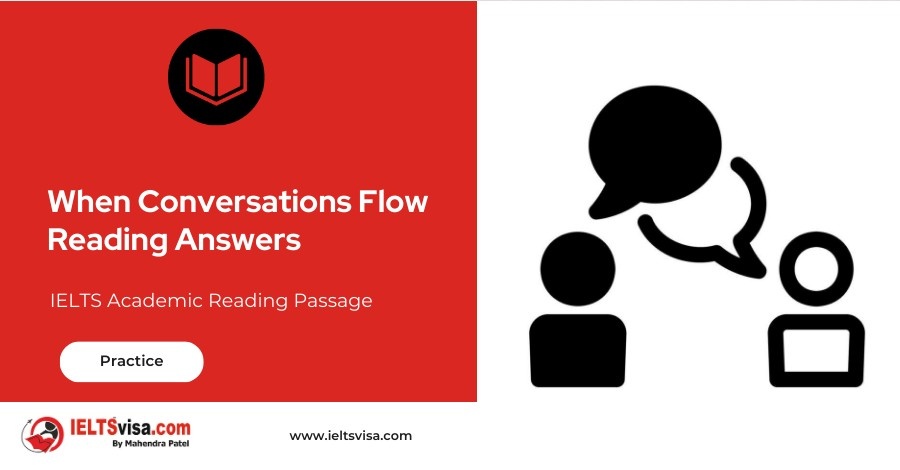When Conversations Flow Reading Answers
IELTS Academic Reading Passage
We spend a large part of our daily life talking with other people and, consequently, we are very accustomed to the art of conversing. But why do we feel comfortable in conversations that have flow, but get nervous and distressed when a conversation is interrupted by unexpected silences? To answer this question we will first look at some of the effects of conversational flow. Then we will explain how flow can serve different social needs.
The positive consequences of conversational flow show some similarities with the effects of ‘processing fluency’. Research has shown that processing fluency — the ease with which people process information — influences people’s judgments across a broad range of social dimensions. For instance, people feel that when something is easily processed, it is more true or accurate.
Moreover, they have more confidence in their judgments regarding information that came to them fluently, and they like things that are easy to process more than things that are difficult to process. Research indicates that a speaker is judged to be more knowledgeable when they answer questions instantly; responding with disfluent speech markers such as ‘uh’ or ‘urn or simply remaining silent for a moment too long can destroy that positive image.
One of the social needs addressed by conversational flow is the human need for ‘synchrony’ — to be ‘in sync’ or in harmony with one another. Many studies have shown how people attempt to synchronise with their partners, by coordinating their behaviour. This interpersonal coordination underlies a wide array of human activities, ranging from more complicated ones like ballroom dancing to simply walking or talking with friends.
In conversations, interpersonal coordination is found when people adjust the duration of their utterances and their speech rate to one another so that they can enable turn-taking to occur, without talking over each other or experiencing awkward silences. Since people are very well-trained in having conversations, they are often able to take turns within milliseconds, resulting in a conversational flow of smoothly meshed behaviours. A lack of flow is characterised by interruptions, simultaneous speech or mutual silences. Avoiding these features is important for defining and maintaining interpersonal relationships.
The need to belong has been identified as one of the most basic of human motivations and plays a role in many human behaviours. That conversational flow is related to belonging may be most easily illustrated by the consequences of flow disruptions. What happens when the positive experience of flow is disrupted by, for instance, a brief silence? We all know that silences can be pretty awkward, and research shows that even short disruptions in conversational flow can lead to a sharp rise in distress levels .
In movies, silences are often used to signal non-compliance or confrontation (Piazza, 2006). Some researchers even argue that ‘silencing someone’ is one of the most serious forms of exclusion. Group membership is of elementary importance to our wellbeing and because humans are very sensitive to signals of exclusion, a silence is generally taken as a sign of rejection. In this way, a lack of flow in a conversation may signal that our relationship is not as solid as we thought it was.
Another aspect of synchrony is that people often try to validate their opinions to those of others. That is, people like to see others as having similar ideas or worldviews as they have themselves, because this informs people that they are correct and their worldviews are justified. One way in which people can justify their worldviews is by assuming that, as long as their conversations run smoothly, their interaction partners probably agree with them. This idea was tested by researchers using video observations.
Participants imagined being one out of three people in a video clip who had either a fluent conversation or a conversation in which flow was disrupted by a brief silence. Except for the silence, the videos were identical. After watching the video, participants were asked to what extent the people in the video agreed with each other. Participants who watched the fluent conversation rated agreement to be higher than participants watching the conversation that was disrupted by a silence, even though participants were not consciously aware of the disruption. It appears that the subjective feeling of being out of sync informs people of possible disagreements, regardless of the content of the conversation.
Because people are generally so well- trained in having smooth conversations, any disruption of this flow indicates that something is wrong, either interpersonally or within the group as a whole.Consequently, people who do not talk very easily may be incorrectly understood as being less agreeable than those who have no difficulty keeping up a conversation.
On a societal level, one could even imagine that a lack of conversational flow may hamper the integration of immigrants who have not completely mastered the language of their new country yet. In a similar sense, the ever- increasing number of online conversations may be disrupted by misinterpretations and anxiety that are produced by insuperable delays in the Internet connection. Keeping in mind the effects of conversational flow for feelings of belonging and validation may help one to be prepared to avoid such misunderstandings in future conversations.
Questions 27 – 32
Do the following statements agree with the claims of the writer in the text?
YES – if the statement agrees with the claims of the writer
NO – if the statement contradicts the claims of the writer
NOT GIVEN – if it is impossible to say what the writer thinks about this
27 Conversations occupy much of our time.
28 People assess information according to how readily they can understand it.
29 A quick response to a question is thought to show lack of knowledge.
30 Video observations have often been used to assess conversational flow.
31 People who talk less often have clearer ideas than those who talk a lot.
32 Delays in online chat fail to have the same negative effect as disruptions that occur in natural conversation.
Questions 33 – 40
Choose NO MORE THAN TWO WORDS from the text for each answer.
There is a human desire to coordinate 33 ______________ in an effort to be ‘in harmony’. This coordination can be seen in conversations when speakers alter the speed and extent of their speech in order to facilitate 34 ______________. This is often achieved within milliseconds: only tiny pauses take place when a conversation flows; when it doesn’t, there are 35 _____________ and silences, or people talk at the same time.
Our desire to 36 _____________ is also an important element of conversation flow. According to research, our 37 _____________ increase even if silences are brief. Humans have a basic need to be part of a group, and they experience a sense of 38 _____________ if silences exclude them.
People also attempt to coordinate their opinions in conversation. In an experiment, participants’ judgement of the overall 39 _____________ among speakers was tested using videos of fluency and a slightly disrupted conversation. The results showed that the 40 _____________ of the speakers’ discussions was less important than the perceived synchrony of the speakers.

Solution For: When Conversations Flow
Reading Answers
| 27. Yes | 28. Yes |
| 29. No | 30. Not Given |
| 31. Not Given | 32. No |
| 33. (their) behaviour/activities | 34. turn-taking |
| 35. interruptions | 36. belong |
| 37. distress levels | 38. rejection |
| 39. agreement | 40. content |
Review and Practice
- Regularly practice with IELTS reading samples and time yourself to get used to the pressure of the exam.
- Review your mistakes to understand where you went wrong and how to avoid similar errors in the future.
Our Books
Master IELTS Speaking Part 1
IELTS Writing Task 1 Book
IELTS Writing Task 2 Book
When Conversations Flow Reading Answers Explanation
Comin Soon
Practice IELTS Other Modules
IELTS Listening
The IELTS Listening test assesses how well you can understand spoken English in various contexts. It lasts about 30 minutes and is divided into four sections with a total of 40 questions. The listening tasks become increasingly difficult as the test progresses.
IELTS Academic Reading
The IELTS Academic Reading section assesses your ability to understand and interpret a variety of texts in academic settings. It is designed to evaluate a range of reading skills, including skimming for gist, reading for main ideas, reading for detail, understanding inferences, and recognizing a writer's opinions and arguments.
IELTS Speaking
The IELTS Speaking test assesses your ability to communicate in English on everyday topics. It lasts 11-14 minutes and consists of three parts: introduction, cue card, and a discussion based on the cue card topic.
IELTS General Reading
IELTS General Reading tests your ability to understand and interpret various types of texts. Here are some key areas and types of content you can expect to encounter in the reading section, along with tips for effective preparation.
IELTS Academic Writing Task 1
In IELTS Academic Writing Task 1, you are presented with a visual representation of information, such as graphs, charts, tables, or diagrams, and you are required to summarize, compare, or explain the data in your own words.
IELTS General Writing Task 1
In IELTS General Writing Task 1, you are required to write a letter based on a given situation. The letter can be formal, semi-formal, or informal, depending on the prompt. Here’s a breakdown of the key components to include in your letter
IELTS Academic Writing Task 2
In IELTS Academic Writing Task 2, you are required to write an essay in response to a question or topic. Here’s a guide to help you understand the essential elements of this task
IELTS Exam Tips
To succeed in the IELTS exam, practice regularly, familiarize yourself with the test format, improve your vocabulary, develop time management skills, and take mock tests to build confidence.
Grammer for IELTS
Grammar is the foundation of effective communication in English. Understanding tense usage, subject-verb agreement, and sentence structure enhances clarity and coherence in writing and speaking.
Vocabulary for IELTS
Vocabulary plays a crucial role in the IELTS (International English Language Testing System) exam, especially in the Speaking and Writing sections. Here’s an overview of why vocabulary is important and how it impacts your performance
RECENT IELTS SAMPLES QUESTIONS AND ANSWERS
Ditching that Saintly Image
A. Charities, it is still widely believed, are separate from the government, staffed entirely...
Sleep apnea
1. Sleep apnea is a common sleeping disorder. It affects a number of adults comparable to the...
A leap into history
A Between the Inishowen peninsula, north west of Derry, and the Glens of Antrim, in the east...
Caves
Caves are natural underground spaces commonly those into which man can enter. There are three...
Cure-all Pills: Myths or Reality?
Browse the shelves of any health food shop or pharmacy and you’ll find dozens of dietary...
Dawn Of The Robots
A. At first glance, it appeared to be a typical suburban road accident. A Land Rover...













